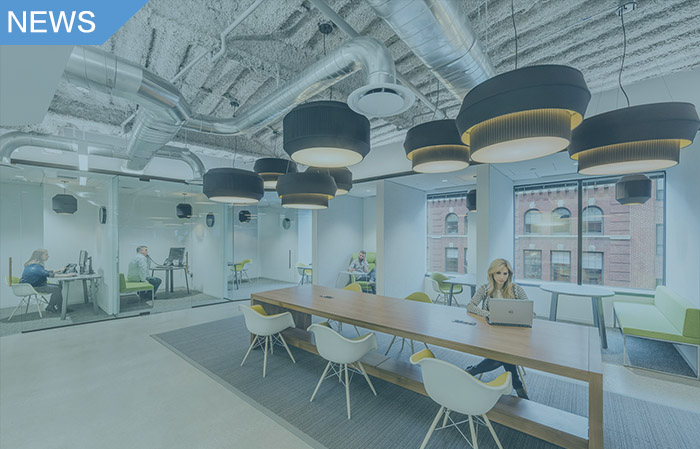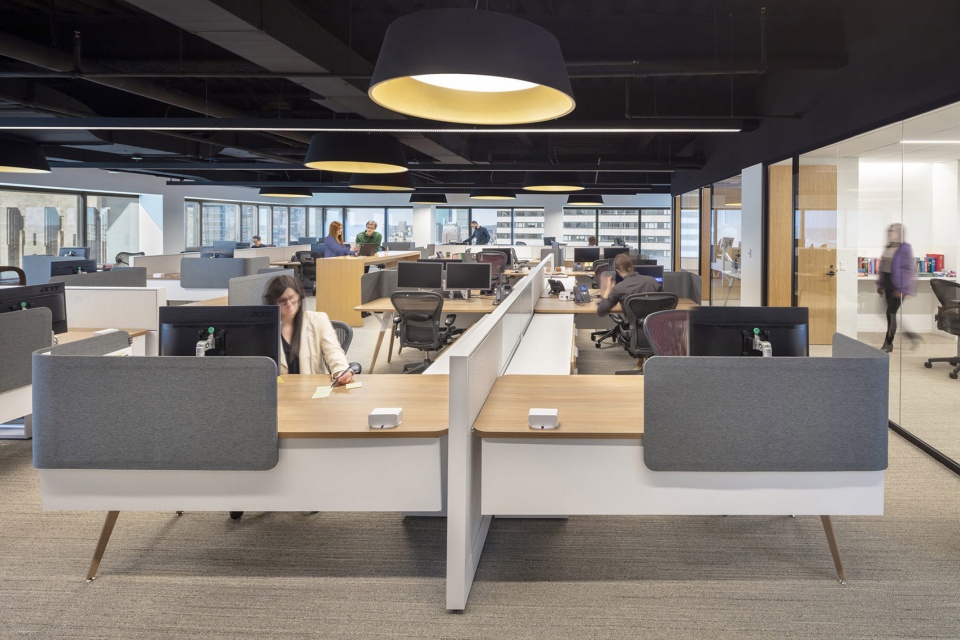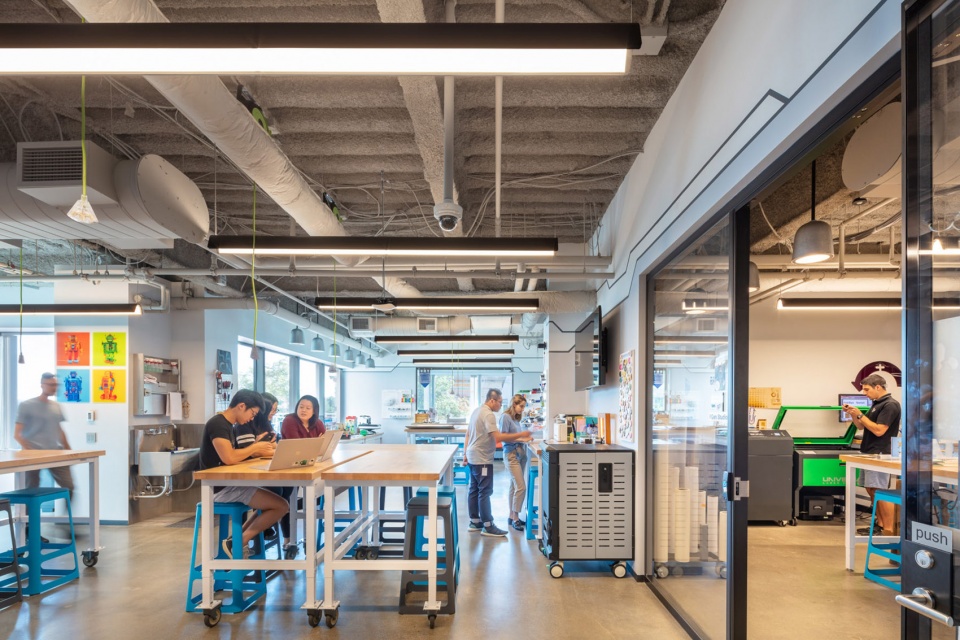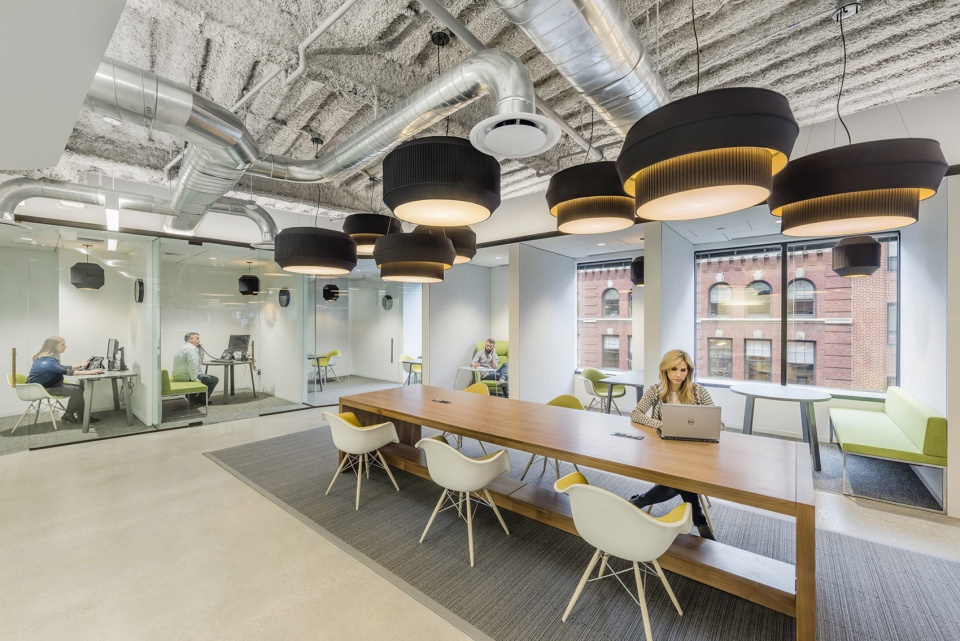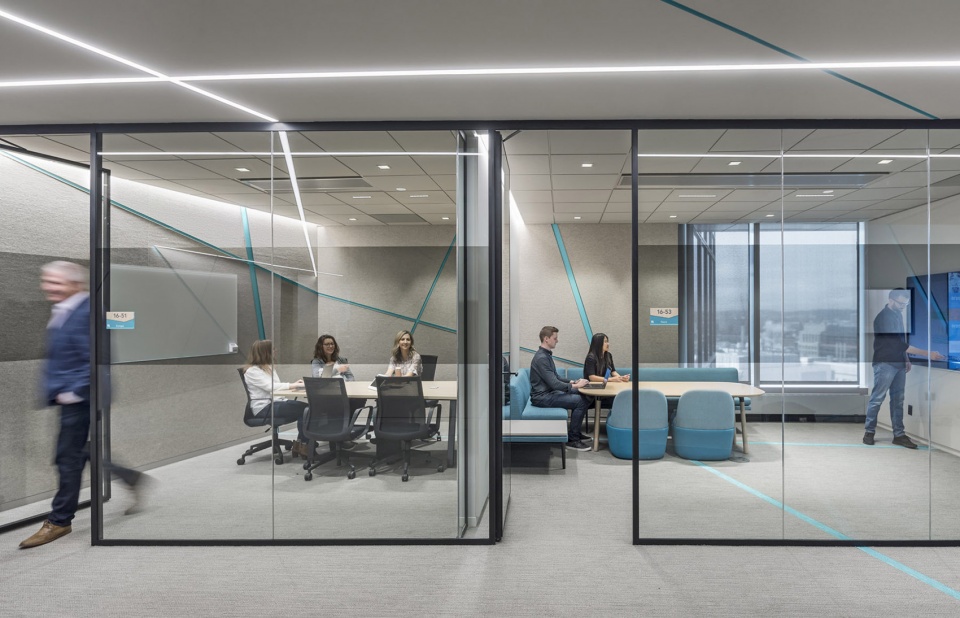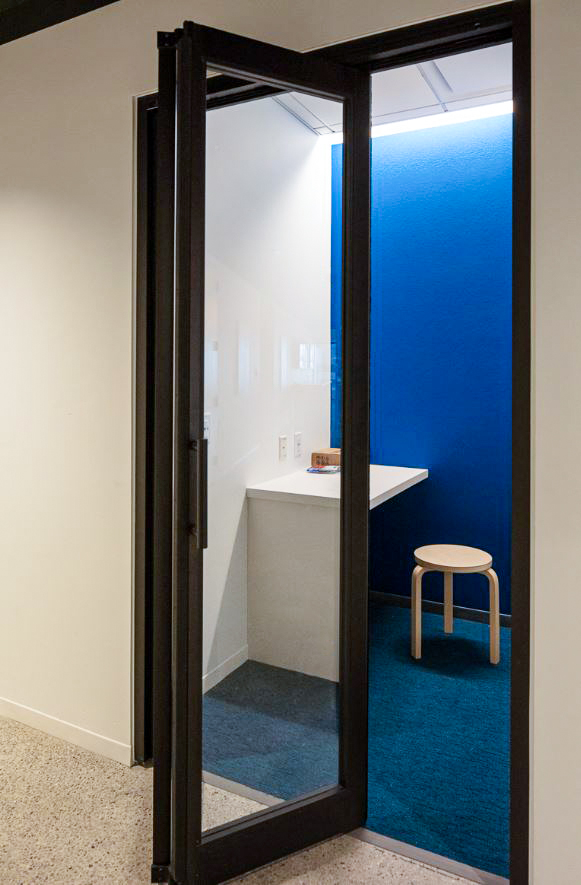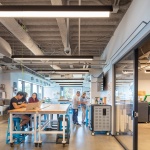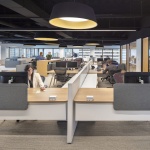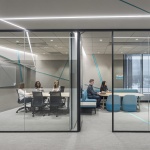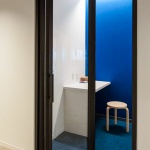来自Sasaki 对gooood的分享。更多请至:Sasaki on gooood
Appreciation towards Sasaki for providing the following description:
一 、疫情前的办公场所
Part I: Workplace Pre-Pandemic
最近,关于疫情的讨论已经从了解 COVID-19 病毒的传播情况,转向考虑我们将在何时以何种方式恢复“正常”生活,其中包括许多对复工后办公场所将如何变化的预测。更有可能的情况是,当我们集体回归办公室时,面对的情况将不会如新闻标题般危言耸听,真实的变化可能更加微妙:我们可能经历一个复杂、无形的变化过程,这一过程也会因人而异和因公司而异。在大胆预测“工作方式的变化”和“新型办公室”之前,我们先回顾一下办公设计近期的演变历程。
转向开放式办公,主要是由我们工作方式的转变所推动的。我们的经济从重复性的、以生产为中心的工作类型,转向创新的、以知识为基础的工作类型,这就代表人们已不再需要办公隔间的那道墙,随着互联网和全球化的发展,以知识为基础的工作日益增多,员工之间的互动被视为一种工作的必须,而不是影响效率的开小差。
知识工作者经常出差,花费大量时间在会议上,同时寻找安静的地方集中精力工作。这种工作的流动性解释了开放办公和“办公桌轮用制 (Hot-desking)”的推广流行——公司提供比员工人数更少的座位,并安排员工临时使用非专属的座位。虽然多数人觉得开放式办公或灵活的座位相比传统办公所需的空间更少,但相应增加的会议空间、协作区、安静区和社交空间通常需要同样多的空间。创新型、协作型的办公室在疫情后仍将存在,但这些空间的具体落实方式有待研究。
Recently, the pandemic discussion has shifted from understanding the spread of the COVID-19 virus to considering when and how we will return to “normal” life, with much speculation over what the workplace will look like for office workers when they return. More likely than not, our collective return to physical offices will be a more nuanced reality than some headlines may suggest: a complex, amorphous recovery, different for each individual and company. Before speculating about the “evolution of work” and the “new office,” it is worth examining the recent history of workplace design.
The shift to open office design was largely driven by a change in the way we work. Our economy shifted from repetitive, production-focused work to innovative, knowledge-based work, which required that cubicle walls come down. As knowledge-based work increased with the explosion of the internet and globalization, employee interaction came to be viewed as an imperative, rather than a distraction hindering productivity.
Knowledge workers travel, spend a lot of time in meetings, and look for quiet places to focus and work. This mobility explains the widespread push for open-desks and hot-desking, the practice of providing fewer desks than the number of employees and seating people at unassigned desks. While many people believe moving to open office or unassigned seating requires less space than more traditional offices, the increased meeting spaces, collaboration areas, quiet areas, and social spaces typically require at least as much space. The innovative, collaborative office will still exist post-pandemic, but the implementation of these spaces will have to be addressed.
二 、疫情后的办公场所
Part II: Workplace Post-Pandemic
随着时间的推移,我们生活的小部分将恢复“正常”。许多经济学家和科学家预测,可能需要18个月以上的时间,我们才能恢复到某种程度的正常状态。而实体办公的恢复,则将取决于许多因素,其中包括人们对通勤和办公场所的安全感。
无论完全复工需要3个月还是18个月,从这场全球性疫情中恢复的漫长征程,应该是循序渐进的重启,而不是在某个时间点同时恢复到我们所熟知的生活。作为负责设计办公场所以获得最佳体验和生产力的专业,我们能采取的最佳措施,就是以清醒的头脑评估未来的风险,并依据客户的具体需求灵活的解决问题。
这可能是美国历史上第一次在全球流行病中受到如此大的影响,这是一次考验,同时也是一次机会,让我们为全球流行病的再次爆发做好准备。在这个万物互联的现代世界,全球大流行病的风险是我们必须适应的现实。我们是社会性生物,回到工作岗位的动力也是回到社会环境的动力。对身边环境的调整,在短期内会有所帮助,但长期的恢复需要我们找到一种共处的新方式——不仅仅是在办公室,也包括在自家后院烧烤、餐厅及体育比赛中。
Over time, slivers of “normal” life will be ours to claim again. Many economists and scientists project it may take upwards of 18 months to fully return to some semblance of normalcy. The return to the physical office will be dependent on many factors, including how safe people feel traveling to, and spending time in, the workplace.
Regardless of whether it takes 3 or 18 months to fully return to work, it is clear the long march toward re-emergence from this global pandemic will likely be more of a gradual re-opening than a simultaneous return to life as we knew it. The best thing we can do as a profession charged with designing workplaces for optimal experience and productivity is to approach this challenge with a clear-headed assessment of what may lie ahead, and flexible problem-solving that fits the specific, evolving needs of each client.
This may be the first global pandemic that has touched America so severely, but this is also a trial and an opportunity to be better prepared for a resurgence of the next pandemic that may befall us. With our interconnected modern world, the risk of global pandemics is a reality we must adapt to. We are social creatures and the drive to return to work is also a drive to return to social settings. Adaptations to places we frequent will help some in the short-term, but the long-term recovery will require we solve for a way to be together again—not just in the office, but also at backyard barbeques, restaurants, and sporting events.
▼演讲厅空间模型,model of lecture hall © Sasaki
家不会永远成为办公室 | The Home Will Not Become the Office Forever
在 COVID-19 的旋风中,Sasaki 的设计师也感受到了一些超越行业的新常态:即便是像我们这样的协作密集型行业,也学会了如何利用技术远距离工作。同时,我们也认识到远程工作的局限性——面对面的草图沟通是无法通过视频通话复制的。
许多公司可能正在经历类似体验,这也使员工希望至少一周中的部分时间可以回到办公场所。新技术的采用所提供的灵活性,以及围绕着远程工作的灵活企业政策,将改变我们在办公室工作时的体验和期望。
几乎所有与我们交谈过的人都对回归办公室感到兴奋。面对面的谈话更有效率,人们更活跃,在家中缺乏符合人体工程的设计,这些因素都是我们重返办公室的动力。很显然,对很多人来说,我们的家并不适合这种生活方式,家应该是家,工作应该是工作。
In the whirlwind of COVID-19 Sasaki designers have come to a few shared realizations that cut across industries: we’ve learned how to implement technologies which have made work from afar possible—even for a collaboration-intensive industry like ours. At the same time, we’ve recognized there are limits to remote connection—collaboratively sketching a drawing simply cannot be replicated via a video call.
Many companies are likely experiencing similar revelations, which will result in workers desiring a return to the physical office, at least for part of the week. The flexibility offered by mass-adoption of new technologies, and perhaps more flexible policies around remote working, will change our experience and expectations for time in the office.
Almost everyone we have spoken with is excited about returning to work. Conversations are more effective in person, people are more active, and a lack of ergonomics at home are all motivating factors for a return to the office. It has become clear that for many, our homes weren’t meant for this lifestyle, and that home should be home and work should be work.
办公室将不再像家一样 | The Office Will Be Less Like the Home
办公室的空间设计和活动安排越来越受到家居设计的影响,其目标是让员工在一整天中都感到舒适。关于实体空间的设计,我们预计办公室和家居的融合趋势将逐渐消失。许多公司都努力让自己的办公室尽可能的舒适和方便,提供 24 小时免费餐食、干洗、高端健身房、健身班、托儿所、午睡室等设施——目标都是让员工愉悦地保持工作。随着居家工作的体验历历在目,许多员工可能会意识到工作和居家的分离,对心理健康和生活幸福有重要作用。
我们可能会看到“居家商业”美学在设计中的逐渐衰落,而这一美学在过去几年中都是炙手可热的潮流。“居家商业”设计将住宅设计美学融入到商业环境中,创造出像客厅和厨房一样的办公室。全球疫情的流行,提供了一个创造新的办公场所设计语言的机会,让人们可以有不一样的想象。办公室设计不必是冷冰冰的、一尘不染的,也不必去模仿其他的空间类型,而是需要去寻找符合其本身的设计方式。
Office design and programming has been increasingly influenced by home design, with a goal to make employees comfortable throughout the day. In physical workplaces, we anticipate a move away from the trend toward blending office and home. Many companies have tried to make their offices as comfortable and convenient as possible, offering amenities like round-the-clock free meals, dry cleaning, high-end gyms, fitness classes, childcare, nap rooms—all to keep employees happily at work. With the experience of working from home fresh in their minds, many employees may well come to appreciate just how important separation of work and home can be for mental health and well-being.
We may see the gradual decline of “resimercial” aesthetics in design, which has been a hot trend for years. “Resimercial” design blends residential design aesthetics into commercial environments, creating offices that look like living rooms and kitchens. The pandemic provides the opportunity to create a new language of workplace design, to envision something different. Office design doesn’t need to be cold and sterile but can be itself instead of channeling other spaces.
▼演讲厅空间模型,model of lecture hall © Sasaki
布局与动线 | Layout and Flow
由大平层和满满当当的开放式座位所构成的开放式办公平面,在疫情开始之前就已经不再是首选了。许多公司发现,密集的座位对注意力和生产力的影响与所节约的成本相比是得不偿失的。在我们与许多企业的合作中,采用了小型的“社区”和“工作舱”式的灵活办公区,以及固定与灵活座位结合的“团队工作室”,以满足集群办公的需求。我们相信,这种设计方式可能加速推而广之。
旅行受到限制,这将增加对视频通话和会议的需求。视频通话在疫情之前一直就在上升,但现在公司可能会设置更多的电话室或小型视频通话室,一个可能的实现途径,是将大型会议室改造成多个小型视频通话间。
新的技术将把人们聚集在一起。Sasaki 已经开始尝试使用机器人,让人们通过移动屏幕参加会议,在会议桌前“列席”,或者在办公室里自由移动,进行一些非正式的交谈。Verizon、KT 电信和 Vodaphone 等公司正在开发全息电话。这些技术可能很快就会无处不在,技术的进步可能会以我们无法想象的方式彻底改变办公环境。
在保持社交距离的规定下,作为短期的回应措施,一些设计师开始倡议在办公室内设置指示牌和楼层提示,以保持单向人流。根据我们的经验,通过设计来控制人的行为和移动不会形成长期习惯。设计的历史已经证明,人们总会选择最短路径。
Open-office plans featuring large rooms full of open-office seating had already begun to fall out of favor prior to the pandemic, as companies have found the detriments to focus and productivity do not offset the cost-savings of tightly-packed desks. We have worked with many companies to create smaller “neighborhoods” or “pods” of agile seating, and teamwork rooms which allow for clusters with partially-assigned seats. We believe this approach will likely gain traction at an accelerated clip.
Travel will be limited, which will put an increased demand on video calls and meetings. Video calls were on the rise prior to the pandemic, but now companies will likely be looking to invest in more phone-rooms or small video call rooms, perhaps by converting larger meeting rooms into multiple, small video call rooms.
Newer technologies will bring people together. Sasaki has already begun experimenting with robots that allow workers to attend meetings via a mobile video screen, take a literal seat at the table in meetings, and roam around the office to engage in casual exchanges. Holographic phone calls are in development with Verizon, KT Telecom, and Vodaphone. These technologies may be everywhere soon, as advances could completely revolutionize our office environments in profound ways still unknown to us today.
As a short-term reaction to social distancing directives, some designers have begun advocating specific one-directional flow of traffic within offices, indicated by signage and floor cues. In our experience, directing human behavior-flow through design will not yield new long-term habits. Design has documented that people consistently choose the shortest route to their destination.
“办公桌轮用制 (Hot-desking)”以及为什么我们不会再回到格子间 | Hot-desking and Why We Won’t Return to Cubicles
认为疫情将终结灵活座位的“办公桌轮用制 (Hot-desking)”,可能是对这个议题的过度简化。恢复正常生活可能是分阶段的,每次只有部分人回到办公室:他们可能已经被测试为具备免疫力或健康无感染,以便保持社交距离;也可能是因为我们开发出了疫苗。
每家公司的情况将取决其具体的办公空间策略。许多公司已经采用灵活座位的模式,因为团队成员时常在家或在外办公。短期复工计划可能包括轮流返工的模式——每周轮流让员工回到办公室工作一两天。通过间隔入座,可以在不改变现有座位布局的情况下,让办公室立即重新开放。
这次疫情以及随之而来对保持社交距离的关注,将导致许多雇主扩大现有办公桌面积。我们合作的一个国际客户正在考虑将他们的办公桌标准扩大到6英尺(约1.8米),以创造合适的社交距离。利用透明材料制作座位隔断有助于保持开放式办公的优点——视野、自然光和连接性,同时增加同事之间的健康距离。记住,这只是关于办公场所问题的一部分,我们仍然需要通勤(对很多人来说,这意味着使用公共交通),在商店购物,在餐厅点餐。如果我们只解决了办公室的问题,而不处理日常生活中的其他部分,我们是否能取得实质性成效?
格子间办公的确可以将人们完全分开,但它对企业氛围、文化和创新也是致命的。格子间是如此无趣,以至于诸多笑话、漫画和电影都以取笑它为乐。它代表着过去,工作是重复的、枯燥的,与同事们聊天,意味着你不是在工作而是在打发时间。所幸的是今日的办公文化并非如此。
Projections that this pandemic will spell the end of “hot-desking” at unassigned desks may be over-simplifying the discussion. The return to normal life will likely be in stages, with only a portion of people returning to the office at a time, either because they have been tested as immune or healthy, to manage social distancing, or because we developed a vaccine.
The reality of what is possible for any one company will depend on the workplace strategy created in their office. Many companies have switched to unassigned seating because their teams work from home or outside of the office part time. The short-term return to work could include a plan that brings employees into the office one or two days a week on a rotating basis. Occupying every other desk for the day would require no change to the current workspace and would allow offices to reopen immediately.
This pandemic and ensuing attention paid to maintaining appropriate distance between employees will cause many employers to expand the desk size wherever possible. One global client we work with is contemplating expanding their standard desk size to 6’ in order to create proper social distancing. Integrating transparent materials into workstation barriers should help to maintain the best aspects of open-office seating—views, natural light, and connectivity—while increasing healthy distance between coworkers. Remember this is only one part of the workplace equation, we still have to travel to work (and for many people that means using mass transit), shop at grocery stores, and order from restaurants. If we are solving the office without solving these other parts of our daily life are we really making a difference?
Yes, cubicles created spaces where people were completely separated, but they were also deadly for morale, culture, and innovation, so much so that they have been the fodder of jokes, cartoons, and movies about how uninspiring they are. Cubicles represent the past, a time when work was repetitive and dull, and talking to your co-workers meant you were not working, you were goofing off. That is, thankfully, not the office culture we work in today.
▼演讲厅空间模型,model of lecture hall © Sasaki
清洁一切:空气、物体表面以及办公室新规定 | Cleaning Everything: Air, Surfaces, and New Protocols
供暖和制冷系统可以在改善室内空气质量(IAQ)方面发挥关键作用,因此这对减少 COVID-19 的散播至关重要。建筑可以采取的三个步骤:包括增加室外换气,保持或增加室内通风率,以及增加系统的过滤效率。WB 工程 + 咨询公司 (WB Engineers+Consultants) 的管理总监 Peter Dussault 表示:“简而言之,这些措施的核心就是冲走污染空气,引入清新空气。通过在系统允许的情况下尽可能多使用室外空气冲洗空间,然后使用紫外线灯或电子空气净化器去除空气中的有害颗粒物,我们可以让办公场所重新可居可用。”
办公桌与各种台面,是我们在办公室中最常接触的物体表面,部分合成石英板或复合板材可以采用抗菌处理。布料也可以用化学喷洒处理。然而这些材料在视觉上与未经处理的表面无异,可能与未处理材料混用,因此人们可能无法意识到其保护功能。因此,显而易见的手段将更受欢迎,如在关键位置采用非触控技术,例如入口处、厨房水龙头及浴室等。通过人工智能(AI)技术,使用语音控制激活照明和会议系统,也是向低触控环境转变的方式。
不言而喻,办公场所和电脑设备的日常消毒政策将更加严格。对于座位的个性化装饰将让给更切实的需求,我们需要易于日常清洁的干净台面,也需要新的办公室规定:一天工作结束时对台面擦拭消毒,以便第二天早上安全使用。这一规定也将加剧我们对干净空旷的办公台面的需求。
Heating and cooling systems can play a key role improving Indoor Air Quality (IAQ), which plays a critical role in reducing COVID-19 exposure. Three steps that buildings can take include increasing the amount of outdoor air to the space, maintaining/increasing airflow rates to the space, and adding higher efficiency filtration to the systems. “The easiest way to think about the value of these measures is that they will flush out the bad air and bring in the clean air.” says Peter Dussault, Managing Principal of WB Engineers+Consultants, “By flushing the spaces with as much outside air as a system will allow, and then using ultraviolet lamps or an electronic air cleaner to remove dangerous particulates in the air stream, we can make workplaces occupiable again.”
Countertops and desks are some of the highest touch surfaces in offices, and there are some synthetic quartz and laminate materials that have antimicrobial treatments available. Fabrics can also be treated with spray-on chemicals. These materials do not look different, which could present problems if not distinguishable from untreated surfaces and therefore not recognized for having built-in protection. Obvious interventions like touchless technologies in key areas like entryways, kitchen faucets, and bathrooms will be more popular. Artificial intelligence (AI) technologies that enable voice-controlled activation of lighting and conferencing systems are other ways of moving to a low touch environment.
It almost goes without saying that policies around daily sanitization of workspaces and computer hardware will become a strict norm. The inclination to decorate desks with personal items will give way to the practical need to have clear desks that are easy to clean on a very regular basis. A protocol requiring a clear, wiped down surface at the end of the workday ready for safe occupancy the next morning will compound the need for clean desks.
新的远程工作和病假政策将改变办公形态和办公空间 | Remote Work and Sick Leave Policies Will Change Work and Offices
持续的视频会议,让我们都能一窥同事们的生活,这让我们意识到每个人所面临的各种挑战。无论是照顾年迈的父母,生病或残疾的亲人,还是孩子,许多美国人在全职工作的同时,还要兼顾照料家庭的责任。而在这次疫情发生之前,另一种疾病——孤独和寂寞——也普遍存在于在不同年龄的人身上。
这场悲惨的全球公共卫生危机的一个结果是:我们都增强了对他人的同理心。正如许多人所感受,更灵活的远程工作政策,以及更有效和更受尊重的病假政策,是这次疫情的积极结果。这些转变将有益于在传统工作文化 (强调面对面对谈及待在办公室的时间) 中处于弱势的群体,他们将获得更多的工作灵活性以及工作机会。如果这些政策得到大范围推广,将对个人、家庭和公司影响深远。即使如此,面对面交流的需求也不会消失,即便更多的员工选择外出工作,办公室空间依旧重要。因此,疫情后办公室设计的演变将是全社会合力的结果。
Peering into the lives of our coworkers through near-constant video conferencing has given all of us a window into the many varied challenges we all face. Whether caring for an aging parent, an ill or disabled relative, or children, many Americans are juggling demanding home-care situations alongside full time jobs. The other widespread ill that pre-dated this pandemic—isolation and loneliness—also runs rampant with people young and old.
One of the good outcomes of this otherwise tragic global public health event is that we have collectively developed greater empathy for others. Many have already pointed to the rise of more flexible remote-work policies and the advocacy for more robust and more-respected sick-leave policies as positive outcomes to this pandemic. These societal shifts would give flexibility and access to those who may otherwise be disadvantaged in a work culture that historically prizes face-time and hours in the seat. If implemented at scale, the effects on individuals, families, and companies will be significant. Even so, the need for in-person exchange will not go away, and the office will continue to remain vital even if more employees choose to work outside of them, so the evolution of office design post-pandemic will be an important societal endeavor.
▼演讲厅空间模型,model of lecture hall © Sasaki
三、疫情后的人们
Part III: People Post-Pandemic
疫情之后,办公空间会发生变化,但同等重要的是,回到办公室的我们将有什么不同?员工在复工后会有什么期望?雇主们是否会做出政策上的改变,以应对在家工作,减少旅行,并争取更多时间与自由的期望?很显然,政策会因公司而异,但当经济复苏时,那些制定相应策略的公司在招聘市场上将占据先机。
比政策更重要的是我们每个人回到工作岗位后的心态。我们是否会因新的工作政策而赋能,还是依旧担心因缺乏面对面工作的时长而失去晋升机会?正是由于这个原因,员工在疫情之前并没有充分利用灵活工作的选项。需要来自雇员的倡议和来自雇主的支持,这一现状才能真正有所改变。
在我们都被迫居家之前,这是一个忙碌的社会。商业活动中,很多对话都是围绕着自己有多忙,仿佛这是一种荣誉。我个人希望,当我们回到工作岗位上时,我们已经休整良好,做好准备保持高效而非忙碌。全世界的人都在利用这个空档,反思自己生活的优先顺序,很多人发现,健康、家庭、和亲近自然是这个列表中更重要的事项。这种观念的转变,超越办公室的实体转变,将是我们有生之年可能看到的,办公场所的最大转变之一。
The office itself will be rethought as we return post pandemic, but equally importantly is how will we be different when we return to the office? What expectations will employees have as they return to work? Will employers make policy changes to reflect what we assume will be increased desire to work from home, reduce travel, and for more freedom of schedule? Obviously, policies will vary by company, but those who plan adaptive strategies will have a great recruiting tool when our economies recover.
Even more important than policies is the mindset each of us brings back to work. Will we feel empowered to take advantage of new workplace policies or will we still fear a lack of face time will inhibit opportunities for advancement? Employees were not fully taking advantage of workplace flexibility options before the pandemic for exactly this reason. It will take both employee advocacy and employer support for norms to change.
We were a busy society before we were all sent home. At business events many conversations centered around how busy each of us were as if it were a badge of honor. I personally hope that as we return to work we do so rested and ready to be productive, not busy. People across the world have taken this time to reflect on their priorities, and many are finding that health, family, and connection to nature rise to the top. That perspective shift, beyond any physical change to the office, will be one of the biggest changes to the workplace we may see in our lifetimes.
那么,下一步是什么?| So, What’s Next?
除非员工在通勤与工作时感到安全,否则他们不会迅速回到办公室。这意味着我们都在等待着疫苗研发与量产。在这期间,未来几个月将是一个窗口期,企业需要思考不同情景下的计划安排以及办公场所的调整方式,以为充满不确定的短期未来做好准备。
现在最可以确定的是:没有人知道未来会发生什么。在设计未来的办公场所时,我们可以给客户最大的建议是:进行短期投资,以适应长期使用——这也是我们经常给客户的建议。相信自己对企业、文化和人员的了解,基于现有信息做出最明智的选择,并在未来不断完善。
我们的生活可能不会全然像疫情之前那样,但假以时日,我们一定可以再次外出就餐、去听音乐会、参加体育赛事、送孩子们上学以及返回办公室。群策群力,我们一定能获得亟需的检测和疫苗以继续前进。
Employees will not come back to offices in large numbers until they feel safe commuting to and being at work. This means we are all in a holding pattern awaiting a widely-distributed vaccine. In the interim, the next several months offers a window for companies to think through scenario plans and workplace adjustments to prepare for an uncertain, short-term future.
The prediction we feel most confident in making is that no one knows exactly what is going to happen; the greatest advice we can give our clients in designing workplaces of the future is to make short-term investments that can flex for long-term uses—which, incidentally, is what we always advise our clients to do. Trust your knowledge of your business, culture, and people; and make informed choices that you can refine with more inputs as time goes on.
Life may not return to what it was before the pandemic, but in time, we will again be able to dine out, go to concerts, attend sporting events, see our kids off to school in the morning, and go to work again. Collective ingenuity will surely bring about the testing and vaccines we need to move forward.
▼演讲厅空间模型,model of lecture hall © Sasaki
Writer:Elizabeth von Goeler
More: Sasaki 更多关于他们:Sasaki on gooood.
